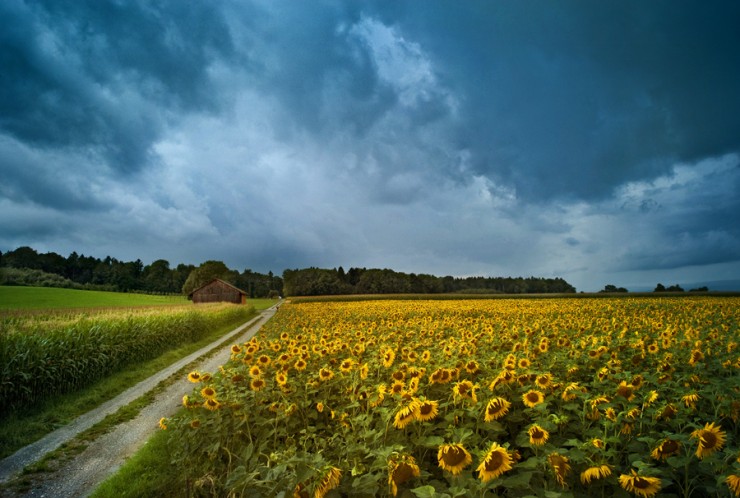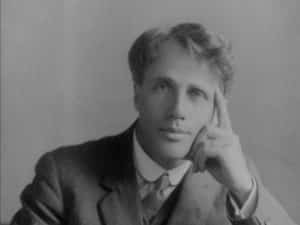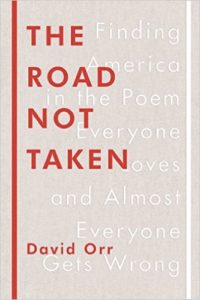
In 1912, poet Robert Frost (1874-1963) and his family moved to England. His writing career was not happening in the United States, and a flip of a coin made the decision for England instead of Canada. It was in England that he was finally offered a contract by a British publisher. The resulting book caught the attention of a British poet and literary journalist, Edward Thomas (1878-1917), and Frost and Thomas became good friends.

Robert Frost.
Frost sent Thomas a poem, entitled “Two Roads, ” which Frost thought of as a kind of joke about Thomas’s indecision and a parody on the romantic imagination.
They often took walks in the countryside together, and Frost was often amused by his friend’s indecision as to which walking route to take, and then to regret the one chosen. Frost later sent Thomas a poem, entitled “Two Roads, ” which Frost thought of as a kind of joke about Thomas’s indecision and a parody on the romantic imagination. For his part, Thomas seemed not to realize it was meant as a joke, and took it quite seriously, as the exchange of letters between the two indicates.
Thomas eventually enlisted in the British Army, and died in 1917 in France. Today he’s known as one of the World War I poets. Frost went on to become, more than anyone else, the “American Poet.” And his poem, “Two Roads, ” was renamed, and became “The Road Not Taken, ” perhaps the best known American poem of the 20th century, and perhaps the best known American poem, period.
The Road Not Taken
Two roads diverged in a yellow wood,
And sorry I could not travel both
And be one traveler, long I stood
And looked down one as far as I could
To where it bent in the undergrowth;
Then took the other, as just as fair,
And having perhaps the better claim,
Because it was grassy and wanted wear;
Though as for that the passing there
Had worn them really about the same,
And both that morning equally lay
In leaves no step had trodden black.
Oh, I kept the first for another day!
Yet knowing how way leads on to way,
I doubted if I should ever come back.
I shall be telling this with a sigh
Somewhere ages and ages hence:
Two roads diverged in a wood, and I—
I took the one less traveled by,
And that has made all the difference.

And it’s misunderstood for the simple reason that it doesn’t say what we think it says. The poem is actually far more complex than what so many of us have heard in countless graduation ceremonies. And there is essentially no difference between the two roads.
Orr is a poetry columnist for The New York Times Book Review and a professor at Cornell University. His first book, Beautiful & pointless: A Guide to Modern Poetry, was published in 2011 (and we reviewed it here at Tweetspeak Poetry). He brings a wealth of perspective, ranging from history and poetry to the science of the brain, to the subject of this poem.
He considers the poet, who Frost was (and wasn’t), his biography, and the biographical context for the poem. He then analyzes the poem itself, asking what in hindsight look like obvious questions. He then discusses the choice of roads, the whole notion of choice and its place in the American psyche and the idea of roads as opposed to paths. Finally, he examines the chooser, who it is who’s confronted with the choice of roads.
Orr notes that readers were captivated by the “thrill of sincerity” they found in Frost’s poetry. “The perception of authenticity became Frost’s trademark, at least among general readers, ” he writes. His looming presence in American poetry, reaching its height in the 1950s and especially with the inauguration of President Kennedy in 1961, at which Frost started to read a poem he had written for the occasion and then discarded it, reciting another (and better) one from memory.
That presence barely survived his death. In the iconoclastic 1960s and 1970s, Frost’s reputation suffered greatly, first at the hands of his official biographer and then at the hands of academics. He became known as a “monster, ” Orr writes, on the basis of very little evidence. But “The Road Not Taken” fared better, and continued as a staple in school graduations. The academics may have sniffed at Frost, but he was still loved by general readers.
One hundred years after its first publication (August marked the centennial), “The Road Not Taken” remains a beloved American poem. Even with its contradictions and misunderstandings, it remains an important of the American poetic landscape.
Photo by Daniele Zedda, Creative Commons, via Flickr. Post by Glynn Young, author of the novels Dancing Priest and A Light Shining, and Poetry at Work.
__________________________

“I require all our incoming poetry students—in the MFA I direct—to buy and read this book.”
—Jeanetta Calhoun Mish
- Poets and Poems: Mary Brown and “Call It Mist” - September 18, 2025
- “Horace: Poet on a Volcano” by Peter Stothard - September 16, 2025
- Poets and Poems: The Three Collections of Pasquale Trozzolo - September 11, 2025

Mary Sayler says
Glynn, thanks for helping poets and poetic writers in our Facebook group discover more about poets and poetry. I’ll highlight your post on the Christian Poets & Writers blog – http://www.christianpoetsandwriters.com. God bless.
Glynn says
Mary – thank you!
L. L. Barkat says
I wrote about this once (link within post 🙂 ), and I have to say that it was fascinating but somehow sad. Is that too simple a word? Here’s this poem that so many people have used for vision and comfort, and we find that Frost meant it as a tease to an indecisive friend. (Frost was a bit mischievous, but also even fatalistic, as a poet, which I think people also sometimes find disappointing). It definitely shows the power of poetry, beyond the poet’s intentions. Thomas was killed partly as a result of this poem (though one could argue he was dying a slow death through his untreated depression otherwise anyway). People have lived because of this poem. And none of it… did Frost intend.
Maureen says
Thank you for adding these details.
It’s rather rare these days to find someone like Orr who knows how to do close textual analysis that offers insight into a poem. Helen Vendler is one other.
Analysis like Orr’s is fascinating, yet one response – and I think it’s justified – is, So what? Especially given a poem like this one, which has, as L.L. notes, “saved” people. I’m one of those who believes a poem can “save” us.
The subject of meaning and understanding reminds me of the tiresome arguments about visual art, especially abstract art, which people dismiss because its “meaning” is not obvious. Meaning? Sometimes, we just need to let go into the experience, whether of words or paint. Sit with a Rothko long enough and you will know what I mean. Some poems are like Rothko’s paintings, too.
L. L. Barkat says
Sara and I got in a discussion about this today, and we entered the territory of… who does a piece of art belong to? Surely it belongs partly to the artist. But once it is shared publicly, it takes on a life of its own—sometimes far outside of our intentions. It was a fun discussion that also ended up including Sherlock Holmes and Doyle (Doyle wanted to stop writing about Holmes and his readers were not on board with that 😉 ) and Stephen King (that movie where the reader decides to “help” the stranded writer (creepy movie!!), because she thinks he’s no longer writing what he should in a particular story set.)
Glynn says
One might argue (who, me?) that any work – a painting, a poem, a novel, a piece of music – isn’t art until someone other than the artist sees it or experiences it. Until then, it is simply personal potential. As L.L. and Sara discussed, once it’s shared, it becomes something else entirely. I had this very same experience with my first novel. For years, I allowed no one to see the manuscript. Then one person read it, then two and three, and then it was published. Somehow, a pastor of a large church in Kentucky got his hands on it, and saw something in it than I hadn’t planned or intended. He had his entire elder board and church staff read it, and then contacted me. When he told me what he saw, I could see it – but I had never intended it.
Rick Maxson says
In college, I was going to include Frost as an example of rural “homespun” poetry in a thesis. When I informed my advisor (named Tony Stoneburner) of this, he smiled and asked why I looked on Frost as that simple or straightforward? I replied that he wrote poems like, The Road Not Taken, Mending Wall, Birches etc. Poems about a bucolic environment that was quickly disappearing. He smiled bigger and suggested I read A Servant To Servants and Home Burial before proceeding with my thinking.
It was both a disappointment and an awakening to my lack of perception to read those poems. I’ve heard it said that to read and fully understand Frost’s body of work is to fully understand the art of poetry.
Glynn says
Richard, I was in high school when I first read the poem, part of the curriculum (and textbook). I and the rest the class understood the traditional and conventional meaning. My teacher made us go back and restudy it — she said appearances can be deceiving. And we did, and while we didn’t do the in-depth study done or have the in-depth understanding that David Orr has in his book, we did see some puzzling inconsistencies. (I had a good English teacher that year. In fact, I had great English teachers during all four years of high school.) Frost is not necessarily the “new England poet of the land” that we thought he was. Or perhaps he is, and more.
Bethany R. says
Fascinating post and discussion. I imagine it’d be quite interesting to find out how someone applied your poetry to their life – especially if their takeaway was utterly different from your own. Have you, L.L., Maureen, Rick, Glynn and others, encountered this? What was that experience like for you as the artist?
Glynn says
Bethany, see me comment to L.L. and Maureen’s comments above. When that pastor first told me what he saw, I found it a bit unsettling. I actually went back and reread my own novel — and discovered he was right. I had another reader tell me it should be required reading for every teenage boy to understand what it means to live a noble life — and that, too, caused me to go back and reread it. What I learned is that sometimes the people who see what you’ve created understand it better than you yourself.
L. L. Barkat says
I’ve had people tell me that my sad poems are happy and hopeful, or that my poetry or prose is crass (and how dare I have written that and I should be ashamed), or that my words have (for the better) changed someone’s life. The way I see it is that readers bring a past, or dreams, or angers, or openness, and they find what they want (even though I feel there is a better or worse reading of a poem or a book, based on its signals). Mostly I just smile to myself about all this, though I admit I don’t prefer to be told what I should or shouldn’t have written 😉 (By which I mean…I do take my responsibility as a writer very seriously and I don’t put things out there unless I think they deserve to be out there.)
Maureen says
What comes to mind: Sometimes, a poem is just a poem.
I tend to regard a lot of criticism, whether about literature/poetry or visual art, with skepticism. It’s just someone’s opinion or perspective and, unless so off-base as to be hurtful, it’s generally not worth getting exercised about.
Not long ago I received an email from a reader offering great consolation, having assumed the “I” in a poem equated to me and what I was writing about. Uh, no…
That said, quite a few of the poems in ‘Neruda’s Memoirs” are directly my response to and experience of my late brother’s cancer, and I think I make that clear. We can’t help but write out of our experiences.
I don’t aim to be any reader’s vision of me vis-a-vis a poem I’ve written. And I think it’s safe to say readers do create visions of writers are not in the least those writers. (For years I wouldn’t tell people where I went to college because of all the assumptions people held about the particular institution.)
We’re all readers, we all interpret, we all can be forgiven for being off-base.
A friend recently noted that her extraordinary manuscript (parts of which I’ve read) had come back from a prospective publisher with a note that it lacked an “overarching personal story”. The person entirely missed what my friend was doing with those poems (the collection is wonderfully Sophoclean).
Visual art is especially prone to people assigning meaning the artist never gave thought to. Go to any art opening at a museum and listen to some of what is being said. Or pick up a back issue of Art in America, where you’ll find plenty of nonsense-criticism. The digital tool that creates fake Artist Statements is around for a reason.
Bethany says
Thank you for writing our your responses here, Glynn, L.L., and Maureen. Your perspectives and experiences are interesting and helpful to me.